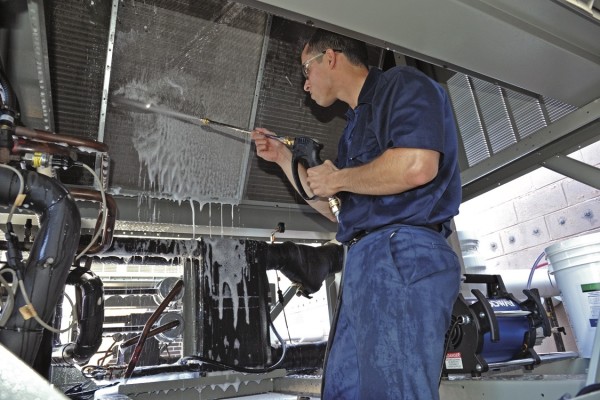With warmer weather on its way, now is the ideal time for facilities to add coil cleaning to the spring-cleaning checklist. Conducting maintenance helps to ensure that HVAC systems are operating efficiently, and clean coils are a large contributor to keeping equipment running smoothly.

“Effectively cleaning your coils can have a big impact on reducing energy costs and help extend the life of the HVAC equipment, which are both beneficial for the bottom line,” said Tim Kane, President and CEO of Goodway Technologies. “Any buildup on coils results in your system needing to work harder than it needs to meet the expected outcome and that increases energy usage.”
When an HVAC system is operating with dirty coils, it can consume up to 37% more power and not perform as effectively as a system running with clean coils. Dirty coils also increase operating pressure and temperatures that break down the compressor’s lubricant and result in equipment failure. A failed compressor means no cooling and some costly repairs.
If that’s not enough to put coil cleaning higher on your spring checklist, consider the impact dirty evaporator coils have on indoor air quality. Coils can become a breeding ground for mold and bacteria as airborne contaminants are filtered through the system, negatively impacting indoor air quality.
Best Practices
Goodway Technologies shared the following coil cleaning checklist for facility maintenance professionals:
- Clear the area for access. Cleaning coils works best when the maintenance technician can get the cleaning wand close to the areas that need to be cleaned. Consider using flexible wands if access is hard.
- Vacuum coils and fins. Before cleaning, remove dry debris from the coils with a vacuum that can reach dust and dirt in tight spaces. Other options include using compressed air.
- Clear blockages. The condensate pan and line need to be free of blockages before wet cleaning can begin, as any obstructions can cause major damage due to flooding water from cleaning and HVAC system condensate. Consider a wet/dry vac to suck out any debris prior to cleaning.
- Use a wet cleaning process. Using pressurized water forces deeply embedded dirt and debris to come loose, vastly improving the cleaning process.
- Use a powerful, yet delicate cleaning system. High-pressure equipment can damage fins, especially on evaporator coils. The ideal system should deliver no more than 400 PSI, and plenty of water flow.
- Apply an alkaline non-caustic cleaning foam. Using a non-caustic cleaner will help protect coils from corrosion. Such products can expand after being sprayed onto the coils to clean in tight spaces.
- Apply a mold control agent. Adding an EPA-registered mold inhibitor can help keep coils clean and free of odor and allergy-causing mold and mildew. Make sure it’s EPA registered and approved for use in occupied spaces.
ALSO READ: Improving IAQ Decreases Health Risks and Boosts Efficiencies
